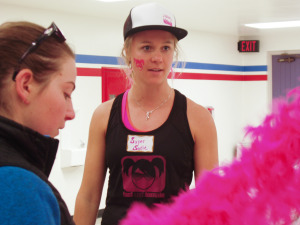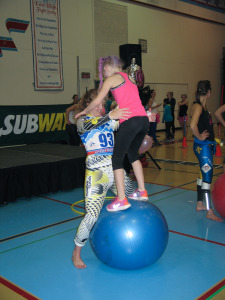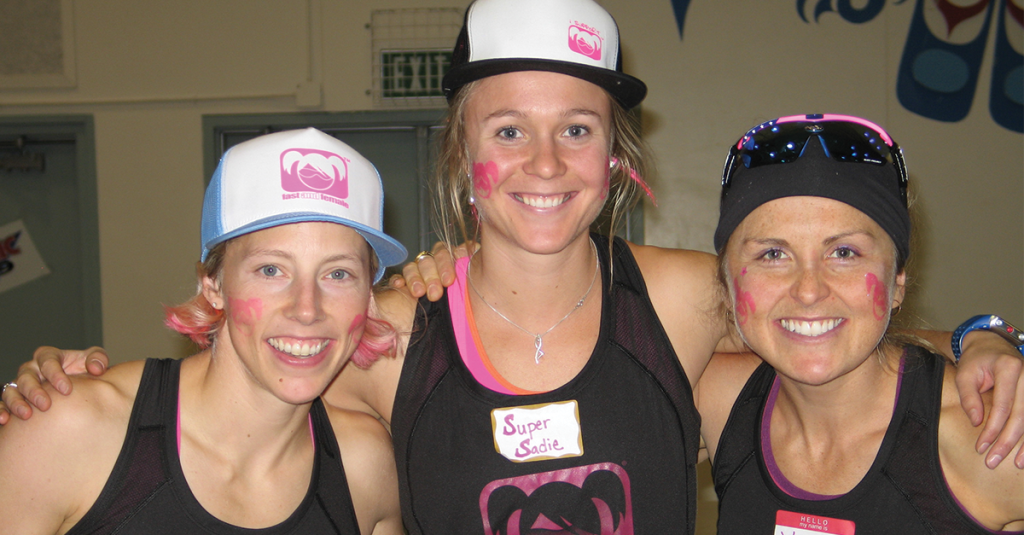Written by Lynn E. Paulson, APU staff writer
I could hear the high-pitched, happy ruckus before I even entered the East Anchorage High School gymnasium, where the event was already in full swing. Over 200 girls, wearing hot pink “Fast and Female” t-shirts, were shooting hoops, lifting weights, walking slack lines, kicking soccer balls, hoola-hooping, tumbling, balancing atop large exercise balls, roller skiing and lying on the floor with their elbows resting on a stack of folding mats, shooting at targets with electronic rifles.
These were just some of the stations between which the participants, ages nine to nineteen, were free to move throughout the Fast and Female event held on September 28th. By the end of the three-hour program of fun, non-competitive athletic activities and informative breakout sessions for girls, parents and coaches on topics like nutrition and sports injuries, their shirts would be covered with the autographs of APU Olympic Nordic skiers Kikkan Randall, Sadie Bjornsen, Holly Brooks and the other two dozen or more elite female athletes from alpine and Nordic skiing, soccer, ski jumping, gymnastics, biathlon, basketball and swimming. Sporting hot pink tutus over their athletic wear, these were the Ambassadors for Fast and Female, a Canadian-based non-profit founded in 2005 by Olympic gold medalist, Chandra Crawford, a cross-country skier from the Canadian National team. They were here to inspire the next generation.
Time and again, research has shown that when girls play sports, they are empowered for life. They learn teamwork and leadership. They have more confidence and a better body image. They suffer less depression, do better in school, and, when they get older, they maintain healthier lifestyles, are less likely to develop breast cancer and are more likely to leave a partner who is battering them.
Even though Title IX came into effect in 1972, achieving equal opportunity for females in sports, like achieving equal opportunity for females in virtually every other arena, has been a slow, and uneven, process. Girls still drop out of sports at twice the rate of boys due to fewer opportunities, poorer facilities, lack of role models or encouragement, social stigma and many other factors. Fast and Female was created to empower girls by offering programs – like the one I attended at East High – that combine athletic activities and mentoring from elite female athletes in order to reverse this trend by encouraging and motivating girls to participate and stay in sports and exercise a healthy lifestyle.
The mission and values of Fast and Female are something Kikkan, Holly and Sadie believe in passionately. All three are using their senior and professional projects for their degrees in Business (Kikkan and Sadie) and Counseling Psychology (Holly) at Alaska Pacific University to develop Fast and Female in new directions. Kikkan and Sadie are researching the feasibility of converting the organization to non-profit status in the U.S. while Holly is developing a Fast and Female curriculum for females over the age of nineteen.

What really stopped me in my tracks, however, was the word “sisterhood.” I can’t remember ever hearing that term uttered by a female under the age of fifty except as a campy concept bracketed with two-fingered “air quotes.” But there it was, from the mouth of Sadie Bjornsen, without a trace of irony.
“It’s about more than competition,” she told the reporter from KTUU. She wanted the girls participating in the Fast and Female event that day to understand that “It’s about the sisterhood, that girls can work together and be the best.”
That girls and women can be world-class athletes with astonishing power, strength, speed and endurance is empirically obvious. What Sadie was getting at in her comments is something that can, and does, undermine female athletes, something that has only gotten attention more recently – the aggression of which females are capable, especially toward one another. That females are by nature gentler and “nicer” than males is a tenacious cultural myth about our sex that functions to shape female aggression in particular ways. While we are capable of acts of spectacular physical violence, female aggression tends overwhelmingly toward passive forms of psychological manipulation, bullying, and abuse that fly beneath the radar and can be readily denied if the perpetrator is confronted. And it is equally as damaging as physical blows.
I spent my childhood and adolescence in the 70’s training and competing in the sport of gymnastics, an arena in which the cruelty of girls, left unchecked, can achieve a kind of gothic perfection. At that time, coaches with a no-tolerance policy for antagonistic behavior stood out. Most coaches turned a blind eye to it. Others, like mine, modeled abusiveness, believing that it inspired the athletes to greater achievement when what it did, in reality, was create a poisonous atmosphere in the gym and a team of anxious and unhappy young athletes who tore into one another at every opportunity. This is exactly the sort of experience that can result in girls quitting a sport they love, like I and many of my teammates did. My experience as an athlete had left me so traumatized, in fact, that it was several years before I could even watch a gymnastics meet on television after I left the sport.
This is what organizations like Fast and Female work to prevent by encouraging a spirit of cooperation and mutual support in young female athletes. I found myself in tears several times that afternoon, remembering my own experience, wishing Fast and Female had been around when I was growing up and thankful that the girls participating in this event could benefit from its existence.
The event wound down with a healthy snack and an inspirational chat with the athlete Ambassadors. Kikkan Randall, head Ambassador for Fast and Female in the U.S., stood on the stage at one end of the gymnasium, mic in hand, and introduced the other athletes, taking special note of Alaska Pacific University Nordic skier and student, Jade Hajdukovich – She was a participant just like you a few years ago and now she’s a leader. You guys are the future leaders! You’re part of a world-wide movement! – and Abby Hughes, a world-class ski jumper and member of the American women’s ski jumping team in Sochi, where, for the first time in Olympic history, women were allowed to compete in her sport. It was something for which Hughes had campaigned hard for many years.
“Don’t take ‘no’ for an answer,” Hughes told the girls. “If they tell you ‘no’ do it anyway.”
Kikkan opened the floor to the participants for questions.
“Did you ever try really hard to do something and fail?” This came from Garvee Tobin, Nora Miller and Carl Tobin’s daughter. None of the athletes responded right away.
“I can give you an example of that,” Kikkan offered. “Last winter I competed in my fourth Olympic games and for the first time, in Sochi, I was favored to win gold, something no American woman had ever done in my sport.” Kikkan explained how she would have to place in the top three spots in each of the quarterfinals of her best event, skate sprints, in order to move up to the finals and compete for a medal. She wasn’t worried going into the first quarterfinal, not even with the mushy snow conditions from the unseasonably warm weather. Kikkan described the race in vivid detail, the feeling of relief when she made it around a tight curve that had caused her to wipe out in a practice run, how the hill that followed put her ahead of the pack (“I’m pretty good on hills,” she said with a grin) and how she was in her top gear, pounding toward the finish with everything she had when she saw two shadows approaching on either side of her. The competition was closing in.

“I wanted to melt into the snow,” she told the 200 girls sitting spellbound in front of her. She not only failed to win gold in Sochi or even medal in her best event, she had failed to make it past the first quarterfinal.
“The dream of gold kept me going for twelve years. Four times I went for it. Four times I didn’t get it. I know I gave it everything I had. I know I gave it my best. And I could have called it a season at that point,” she told them. “I could have gone home for the first time in four months.” But she didn’t. She stayed in Europe for three more weeks, and went on to earn her third World Cup Sprint title.
“I didn’t win the gold medal. But I came home with the crystal globe. When you fail, there’s always another race. There’s always something more. So keep fighting,” she said. “You have two voices in your head. Turn down the volume on the voice that says ‘no’ and crank it up on the voice that says ‘you can do this!’.”
“What do you do when you’re not skiing?” someone asked.
This is what Kikkan Randall does when she’s not skiing. This is what Holly Brooks and Sadie Bjornsen do. They inspire the next generation to stay in sports, to live healthy and to think differently about being female.

